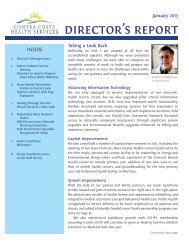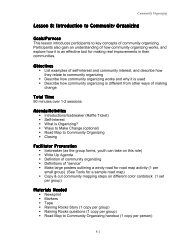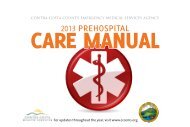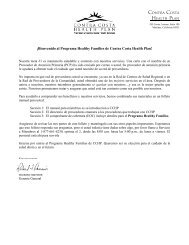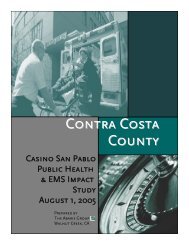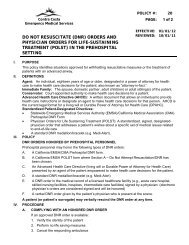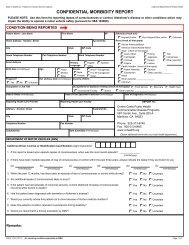EMS Policy Manual - Contra Costa Health Services
EMS Policy Manual - Contra Costa Health Services
EMS Policy Manual - Contra Costa Health Services
Create successful ePaper yourself
Turn your PDF publications into a flip-book with our unique Google optimized e-Paper software.
<strong>Contra</strong> <strong>Costa</strong><br />
Emergency Medical <strong>Services</strong><br />
<strong>EMS</strong> SYSTEM MEDICAL DIRECTION AND<br />
OVERSIGHT<br />
POLICY #: 12<br />
PAGE: 1 of 2<br />
EFFECTIVE: 07/01/12<br />
REVIEWED: 07/01/12<br />
I. PURPOSE<br />
Emergency medical services rendered by <strong>Contra</strong> <strong>Costa</strong> County <strong>EMS</strong> system provider agencies, both<br />
emergency and non-emergency, are accomplished under the medical direction of the <strong>EMS</strong> Medical<br />
Director. This policy defines the scope of medical direction and oversight provided in the <strong>EMS</strong> system.<br />
II. SCOPE OF OVERSIGHT AND DIRECTION<br />
Medical direction applies to all events involving emergency medical care for patients from the initial<br />
request for service to the delivery of patients to receiving facilities. Dispatch, first response, transport<br />
provider care and base hospital direction fall under the auspices of the <strong>EMS</strong> Medical Director or<br />
his/her designee. In addition to emergency and non-emergency scene responses, medical direction<br />
also applies to paramedic (and in some situations to EMT-I) interfacility transports.<br />
Medical direction is provided prospectively through written policies and procedures, approved by the<br />
<strong>EMS</strong> Medical Director, and immediately through on-line communications with the base hospital.<br />
Oversight is also provided retrospectively through quality improvement activities and continuing<br />
education of providers.<br />
Medical direction also includes oversight of <strong>EMS</strong> personnel credentialed by the county. These include<br />
EMTs, paramedics, and base station MICNs.<br />
III. PROSPECTIVE, IMMEDIATE, AND RETROSPECTIVE MEDICAL DIRECTION AND OVERSIGHT<br />
Below is a listing of examples that describe individual facets of prospective, immediate, and<br />
retrospective medical direction and oversight. This list is not all-inclusive.<br />
Prospective medical direction and oversight:<br />
Credentialing of EMT, paramedic and MICN personnel;<br />
Designation of continuing education and prehospital training program providers;<br />
Designation of base hospitals and trauma center;<br />
Review and approval of medical dispatch protocols, including pre-arrival and post-dispatch<br />
instructions;<br />
Provision of the Prehospital Care <strong>Manual</strong>, which guides EMTs, paramedics, and MICNs in the<br />
care provided in the field;<br />
Continuing education activities;<br />
Provision of the Multicasualty Incident Plan;<br />
<strong>EMS</strong> Agency policies.<br />
Immediate (concurrent) medical direction and oversight:<br />
Provision for guidance by MICNs following treatment guidelines from the Prehospital Care<br />
<strong>Manual</strong>;<br />
Provision for guidance by base hospital physicians (including situations defined in the<br />
Prehospital Care <strong>Manual</strong>);<br />
Provision for guidance by base MICNs and physicians concerning interfacility transfers with<br />
regard to scope issues for EMT and paramedic personnel.<br />
Retrospective medical direction and oversight:<br />
Quality assurance and improvement activities, coordinated at the <strong>EMS</strong> Agency level;<br />
Specific incident review and action by base station and <strong>EMS</strong> Agency personnel;<br />
Continuing education prompted by QI data review.



